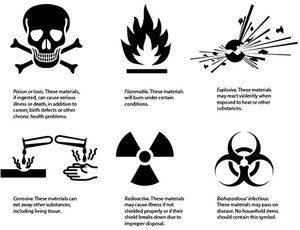Hazardous waste was defined in Study Session 7 as any discarded material that may pose a substantial or potential threat to public health or the environment. Hazardous waste, whether liquid or solid, must be kept separate from non-hazardous waste and requires special handling and treatment. Hazardous wastes may be:
Which of the following waste materials could be considered to be hazardous?
All of these waste materials, apart from food waste, should be considered hazardous.
How do you know whether a waste is hazardous? Many hazardous products are found in Ethiopia but people do not always know how to identify them. It is important that anyone who comes in contact with hazardous materials understands their nature so they can protect themselves and handle the specific product or waste with care to avoid damage to skin, clothes or even property and life. There is an internationally agreed set of hazard symbols, shown in Figure 10.6.

Figure 10.6 Hazardous waste symbols.
You may think that hazardous waste is only produced in factories and hospitals, but you should be aware of household hazardous wastes. These are wastes produced in normal households that have any of the hazardous properties listed above. This could include bleaches and some cleaning products, batteries, paints, pesticides, and pharmaceuticals (Figure 10.7).

Figure 10.7 Some harmful chemicals that can be found in our homes.